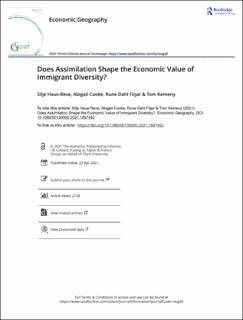| dc.contributor.author | Fitjar, Rune Dahl | |
| dc.contributor.author | Cooke, Abigail | |
| dc.contributor.author | Kemeny, Tom | |
| dc.date.accessioned | 2021-07-01T13:28:22Z | |
| dc.date.available | 2021-07-01T13:28:22Z | |
| dc.date.created | 2021-06-07T14:36:18Z | |
| dc.date.issued | 2021-04 | |
| dc.identifier.citation | Haus-Reve, S., Cooke, A., Fitjar, R.D., Kemeny, T. (2021) Does Assimilation Shape the Economic Value of Immigrant Diversity? Economic Geography, 97(2) | en_US |
| dc.identifier.issn | 0013-0095 | |
| dc.identifier.uri | https://hdl.handle.net/11250/2762870 | |
| dc.description.abstract | A growing literature has shown that greater diversity among immigrants offers material benefits in terms of higher wages and productivity. One limitation of existing work is that it has considered immigrants from a given country to be homogenous. However, immigrants differ in various ways, not least in their level of assimilation. This article considers how assimilation might shape diversity’s economic effects. Intuition suggests two conflicting dynamics. Assimilation could lower barriers immigrants and natives face in interacting with one another, and thus enhance benefits. Equally, however, assimilation could reduce heuristic differences between immigrants and native-born workers, dampening spillovers from diversity. We use linked employer–employee data from Norway to test these ideas. We construct diversity indices at the regional and workplace scale to capture different aspects of assimilation, and observe how these are related to worker productivity, proxied using wages. We find that assimilation dampens externalities from immigrant diversity. Diversity among second-generation or childhood migrants offers smaller benefits than diversity in teenage or adult arrivals. Immigrants’ cultural proximity to Norway, and their experience of tertiary education in Norway, each also reduce the social return to diversity. While assimilation processes may benefit society in various ways, these findings are consistent with the idea that, by diminishing the heuristic gaps between migrants and native-born workers, integration reduces the productivity externalities derived from immigrant diversity. | en_US |
| dc.language.iso | eng | en_US |
| dc.publisher | Informa UK Limited, trading as Taylor & Francis Group, on behalf of Clark University | en_US |
| dc.rights | Attribution-NonCommercial-NoDerivatives 4.0 Internasjonal | * |
| dc.rights.uri | http://creativecommons.org/licenses/by-nc-nd/4.0/deed.no | * |
| dc.subject | immigrasjon | en_US |
| dc.subject | assimilering | en_US |
| dc.subject | lønn | en_US |
| dc.title | Does Assimilation Shape the Economic Value of Immigrant Diversity? | en_US |
| dc.type | Peer reviewed | en_US |
| dc.type | Journal article | en_US |
| dc.description.version | publishedVersion | en_US |
| dc.rights.holder | © 2021 The Author(s) | en_US |
| dc.subject.nsi | VDP::Samfunnsvitenskap: 200::Økonomi: 210::Samfunnsøkonomi: 212 | en_US |
| dc.subject.nsi | VDP::Samfunnsvitenskap: 200::Samfunnsgeografi: 290 | en_US |
| dc.source.volume | 97 | en_US |
| dc.source.journal | Economic Geography | en_US |
| dc.source.issue | 2 | en_US |
| dc.identifier.doi | 10.1080/00130095.2021.1897462 | |
| dc.identifier.cristin | 1914204 | |
| cristin.ispublished | true | |
| cristin.fulltext | original | |
| cristin.qualitycode | 2 | |

